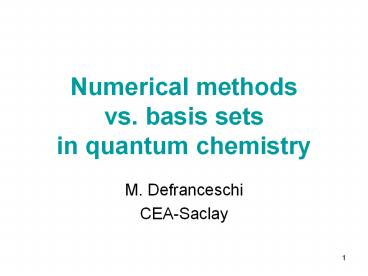Numerical methods vs. basis sets in quantum chemistry - PowerPoint PPT Presentation
Title:
Numerical methods vs. basis sets in quantum chemistry
Description:
Physical functions are square integrable functions (three dimensional measure in ... cusp problem. wrong asymptotic decay. 13. Some attempts of numerical solutions ... – PowerPoint PPT presentation
Number of Views:140
Avg rating:3.0/5.0
Title: Numerical methods vs. basis sets in quantum chemistry
1
Numerical methods vs. basis sets in quantum
chemistry
- M. Defranceschi
- CEA-Saclay
2
Various molecular ab initio models
- Minimization problem
- where
3
For sake of simplicity
- non relativistic equations,
- time-independent model,
- nuclei are points at fixed known positions,
- real-valued functions,
- spin not explicitly considered,
- simplifications to make it more convenient
4
Vector space considered
- Physical functions ? are square integrable
functions (three dimensional measure in the
Lebesgue sense) - Hilbert space
- Reduced to a subspace
5
Overwhelming numerical difficulties
- Problem too difficult to be solved numerically
- Vector space too large
- Non linear terms
6
Two classes of simplification
- Rigourous energy/approximated wavefunction
- Hartree-Fock approx.
- Restriction to a set of functions
- Rigourous density/approximated energy
- Density functional approx.
7
Hartree-Fock settings
8
Mathematical fundation
- Define the energy functional E(?) on a set X of
functions ? (the set of all the possible states
of the molecule). - Then find a function (the
ground-state) satisfying some given constraint
(i.e. constant number of
electrons) and minimize the energy E on the
convenient set of states
9
Notion of physical space
- What are the variables of ?
- Physical notion coordinates can be either
position or momentum (or both) or any other
quantity.
10
First ideas in position space
- Analytical solutions
- Numerical solutions
- Radial function of
in a one-center approximation - Spheroidal cooordinates for diatomic molecules
- Complete numerical integration for diatomic
molecules - In the case of atoms numerical integration are
reliable
11
The quantum chemist procedure
- Molecules are not considered as a whole but as
constructed from atoms. - Use of atomic basis sets
- Slater type
- Gaussian type
- Any functions which contain the correct physical
information. - The procedure most widely used consists in
writing the molecular orbitals as LCAO which
belong to a given complete set of the Sobolev
space
12
Manageable approximate solutions
- Infinite basis sets are impracticable
- Truncated basis sets
- Large expansions but often to small
- Tendency towards linear dependence
- Inherent deficiencies for GTO
- cusp problem
- wrong asymptotic decay
13
Some attempts of numerical solutions
- Integration over a numerical grid
- Finite element method
- Momentum space direct numerical integration
- Numerical solution using a wavelet basis
14
Finite element method
- Very accurate results for even time-independent
problems for simple systems. - Large storage requirement for the FE matrices for
extended three-dimensional systems - Removal of the singularities inherent in the
nuclear potentials.
15
Momentum space approach(1)
- In position space HF equations are
integro-differential - FT of operators and not of functions
16
Momentum space approach(2)
- In momentum space HF equations are first order
integral equations
17
Momentum space approach(3)
- The solutions for bound states ( ) can
be obtained by an iterative procedure starting
with a LCAO in momentum space ( a modified
Lanczos procedure). - Enables to recover basis functions, and then
basis sets not limited in size - Enables to recover the asymptotic behavior.
- Removal of the singularities inherent in the
nuclear and interelectronic potentials.
18
Momentum space approach(4)
trial function first iterate Slater function
1.162569 1.247735 1.248098
0.724396 0.705793 0.750513
1.358986 1.727544 2.322622
19
Momentum space approach(5)
- Disadvantage of a FT of a function is that all
information about its support or its
singularities is lost. - A function with high variations of momenta is
hardly interpretable - A compactly supported function requires a lot of
sinusoidal functions
20
A wavelet approach(1)
- The idea is to realize a decomposition with
vanishing functions which leads to a momentum
representation involving a position parameter - Functions depending on two variables linked to
momentum and position are used
21
A wavelet approach(2)
- A representation is obtained by means of a
decomposition of the Schrödinger operator onto an
orthonormal wavelet basis. - scaling function
- wavelet mother
22
A wavelet approach(3)
- The approach is related to multiresolution
analysis, which is a decomposition of the Hilbert
space into a chain of closed subspaces. - The family defined by the scaling function
constitutes an o.n. basis set for Vj. Let Wj be
the space containing nthe difference in
information between Vj-1 and Vj. It allows to
decompose
23
A wavelet approach (4)
- The two part of a Fock operator has to be treated
in two differents ways - The NS form of the Laplacian operator is solved
iteratively - The NS form of the potential term is obtained by
a quadrature formula
24
A wavelet approach(5)
- The matrix representation of an operator applied
to a vector may be depicted
25
A wavelet approach (6)
STO-1G STO-2G STO-3G Slater
0.4244132 0.4244099 7.78 10-6 0.4857612 0.4857904 6.01 10-5 0.4967535 0.4968063 1.06 10-4 0.5000000 0.5002572 5.14 10-4
-0.8488264 -0.8486610 1.95 10-4 -0.9715744 -0.9711148 4.73 10-4 -0.9937322 -0.9929722 7.65 10-4 -1.000000 -0.9985268 1.47 10-3
-0.4244132 -0.4242511 3.82 10-4 -0.4858132 -0.4853243 1.01 10-3 -0.4969787 -0.4961660 1.64 10-3 -0.500000 -0.4982696 3.46 10-3
26
Conclusion
- The numerical development is far from the state
of the art of the current quantum chemistry
practice based on the use of atomic basis sets.































